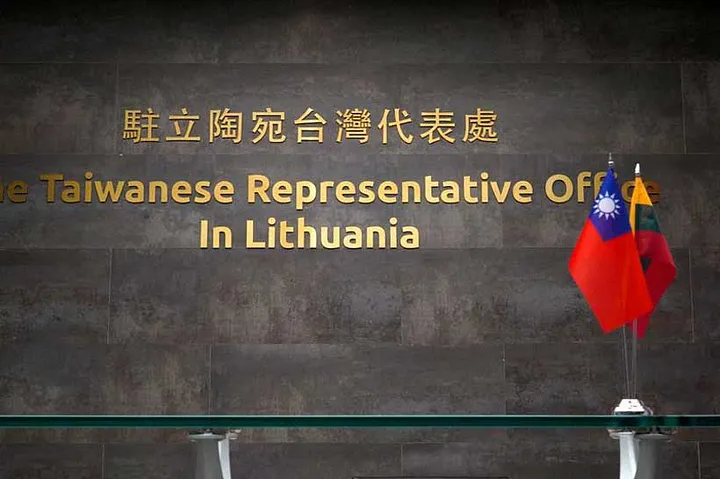pictured Researcher and Author Ben Blandin
(article from KIMS periscope -republished with permission of author
On different occasions over the past years and again very recently, Chinese leader Xi Jinping has warned of Taiwan interference and reiterated that China will not renounce to the use of force against the rebel island and repeatedly asked the armed forces to increase their war readiness and ability to win against any adversary. Back in November 2022, over a call with his American counterpart, Xi Jinping stated that the Taiwan question was at the very core of China’s interests and a red line that should not be crossed. Indeed, Taiwan has been a point of tension between the two countries since very much after the second world war and the retreat of the remaining Kuomintang (KMT) forces from the continent and the island of Hainan to the island of Taiwan and the thereafter creation of the People’s Republic of China in 1949.
在過去幾年和最近的不同場合,中國領導人習近平警告台灣的干涉,並重申中國不會放棄對叛亂島嶼使用武力的可能性,並一再要求武裝力量增強戰備和對抗任何對手的能力。早在2022年11月,習近平在與美國同行的通話中表示,台灣問題是中國利益的核心,這是一條不容逾越的紅線。事實上,自第二次世界大戰結束後,國民黨(KMT)餘部從大陸和海南島撤退到台灣以來,台灣一直是兩國之間的緊張點,並在1949年之後成立了中華人民共和國
Immediately after its victory on the mainland, Mao Zedong thought to taking over all the remaining territories held by the nationalist troops. Given the limited number of available naval assets and the distance of Taiwan’s main island from the continent, the focus was put on the features closest from the mainland and an attack on Kinmen, an island located a few kilometers away from the city of Xiamen. Poor logistics, lack of maritime transport and a gross underestimation of the nationalist troops led to a catastrophic outcome. It was initially thought to launch a second attack, but the Korean war soon became the top priority and the losses at this new conflict did not allow for a new attempt. Instead, Mao felt that leaving KMT forces so close to the mainland would serve as a lasting signal to mobilize the population and maintain permanent readiness.
Despite 70 years of difficult cross-strait relations, punctuated by four Taiwan strait crisis taking place in 1954, 1958, 1995 and 2022, the situation has slowly improved between the People’s republic of China and the Republic of China, at least on the economic side. Under the successive leaderships of Jiang Zemin and Hu Jintao, Taiwan has indeed gradually become a major investor and a driving force for the modernization of the Chinese economy in the 1990s’ and early 2000s, to the point that under President Trump, both leaders, Xi Jinping and Ma Ying-Jeou met in Singapore in 2015. But the election of Xi Jinping as Chairman of the CCP in 2013 and of pro-independence candidate Tsai Ing-Wen in Taiwan in 2016 led to an ulterior deterioration of cross-strait relations, followed by what has unofficially been called the 4th Taiwan Strait crisis in 2022, after the visit of Nancy Pelosi on the island. A sign of these renewed and heightened tensions is that the number of infractions of Chinese ships to the Taiwanese EEZ has increased from 71 in 2018 to 600 in 2019 and 3487 in 2020, while air intrusions to the Taiwanese ADIZ have reached more than 2000 in 2022.
The invasion of Taiwan, a risky bet on all accounts
An invasion or an attack against Taiwan might well become a reality anywhere between now and 2049, with the centennial of the foundation of the People’s Republic of China. Such attack could take many forms, using weapon systems and troops on the ground or under the form of hybrid warfare whether sabotage of key infrastructures, local uprisings, cutting of all internet connections, a no-fly zone over the island or even a hermetic blockade of the whole island. But no matter the means employed, as for all turning points in history, it would not come without a significant number of risks and thus represent a major threat for China’s safety and security, from the economic, political, strategic and diplomatic standpoints.
Geographically, Taiwan is separated from the mainland by the Taiwan strait, a large body of water measuring an average of 180km in width that can turn into a rather unwelcoming environment with a tropical cyclone season spreading from May to November, during which ships suffer powerful winds and currents and waves up to five meters. Crossing such a large distance can take six to eight hours. Economically, the strait is both a major international sea lane with four to five hundred commercial vessels a day crossing to and from China, Korea and Japan, representing between 70% to 90% of these countries respective oil and gas imports and most of their international trade . This trade would be greatly disrupted in case of an offensive operation that could drag on for weeks at least and China would need to rerout maritime trade to the East of Taiwan via the Bashi channel and Miyako Strait but in any case, China’s main ports would likely face a significant drop of their activity and such outcome would in turn generate a significant impact on the national economy. The same would be true with regards to air traffic and all of the southern airports would likely experience a cessation of all traffic for the duration of the military operations.
Politically, depending on the duration of the operations, the major ports of the center and the east side of China could be greatly affected, which in turn could create massive unemployment and thus generate a high level of public dissatisfaction, that may lead to public protest and civil unrest, therefore threaten national stability. Strategically, a victory or a defeat following a direct confrontation with the armed forces of the United States would weaken Chinese military for a significant period of time, and the pacification of Taiwan itself would necessitate for the armed forces to dedicate a large number of personnel to ensure public order on the island, even though controlling Taiwan would create new strategic opportunities for China, particularly to deploy its air force, extend the range of its strategic missile force and its submarines. Diplomatically, no matter the final result and the speed of such outcome, China, depending on the level of destructions and civilian losses, would face massive international backlash and massive political, economic and technological sanctions.
An insufficient invasion force backed by and inadequate logistics
The PLA as a whole represents a formidable force of two million men, three and half million with the People’s Armed Police, and its ground forces alone comprise one million men, twelve times as much as the Taiwanese armed forces. Its navy is now equipped of 400 modern ships and 60 submarines, and its air force can align 5000 aircrafts and helicopters, including 4th generation fighter jets. On paper, all conditions seem gathered to make any offensive operation a swift success, but several points should be taken into consideration.
First, crossing the strait in itself represent a complex and dangerous task and the Chinese armed forces have only two units trained and equipped to accomplish such a technical and perilous mission, the PLAN marines and the paratrooper and airlifted force, amounting to near 80,000 troops. Focusing on the PLAN Marines, this elite dedicated unit comprises 6 brigades totaling 36,000 men, whom only 30,000 are combat personnel. The current PLAN landing ship s would only allow to carry one brigade at a time and all its equipment every 12 hours, and at best 15,000 troops could reach the shores of Taiwan in the first 48 hours, far from what would be needed to make an impact. During that time, the landed troops would experience a significant level of attrition and it is not certain that the ships carrying the 320 Type 05 amphibious fighting vehicles would make it intact and be able to safely put them at sea at a safe yet close enough distance. Of course, the PLA could contribute by providing their own 1500 Type 05 amphibious fighting vehicles, these vehicles could be taken to the front line aboard civilian ships such as RO-RO ferries and PLAN supply ships however, in both cases, these ships do not have the capacity to deploy support vessels while at sea and need port facilities to unload their cargo, therefore making them unsuitable for the preliminary phase of operations. In the latter case, these ships are meant to supply the garrisons in the Paracel and Spratley islands and probably could not be spared. To complement the PLAN Marines, the paratroopers and airlifted troops could be a valuable option but similarly, only 11,000 out of 40,000 personnels are combat-ready. Either dropping or airlifting them to the required sites, in such a highly contested area, would need total air dominance over both the strait and the western part of the island. In fact, even that would not be enough due to the proliferation of man portable rocket systems and anti-air canons spread over a highly urbanized environment, promising heavy casualties in the very first days, if not hours of the operations.
Second, Taiwan is often confused to be one single island when it actually includes a set of islands: the Kinmen islands group facing the city of Xiamen, the Matsu islands group, facing the city of Fuzhou, the Pescadores archipelago, a few sparse islands on the north and east side of the main islands, as well as two islands and a reef in the South China Sea, namely Pratas Island, Itu Aba / Taiping Island and Zhongzhou Reef. Attacking the main island would in any case need full control over the island closest to the mainland in order to secure the following operations but doing so might need weeks and thus suppressing any form of surprise effect and give time to Taiwan’s allies to improve their readiness and bring reinforcements.
Third, the PLAAF would of course be mobilized to suppress enemy defenses, assets and critical infrastructures as well as to establish and maintain air dominance and tactical and close air support to the troops on the ground. To do so, the PLAAF and PLANAF possess more than 5000 aircrafts, either planes or helicopters, including fighter jets, fighter-bombers, and bombers. Several challenges would need to be resolved before such an air armada could be deployed efficiently positioned in Fujian alone. To begin with, Chinese civil aviation authority would need to establish a no-fly zone above the strait and island of Taiwan as well as above the Chinese provinces closest to Taiwan in order to avoid accidental shot down. They then would have to decide on the number of planes to maintain along its borders, particularly with India. Finally, gathering so many planes would need for the Chinese authorities to turn all of Fujian’s civil airports, airfields and airstrips to military use. But hat would probably not suffice, and additional sites would need to be used in neighboring provinces of Guangdong, Zhejiang and Jiangxi for the fighter jets and further away for the bombers, including Jiangsu, Anhui, Hubei, Hunan, Guangxi and Shanghai. From there, establishing and maintaining air dominance would also prove a complex task. Other elements such as pilots experience and pilot and equipment fatigue as well as stocks of spare parts and precision guided ammunitions are important, as much as the attrition rate which, undoubtedly, would be high.
Fourth : the PLAN would of course be a major actor in any scenario against Taiwan and indeed, over the past thirty years, the People’s Liberation Army Navy has grown in both number of ships and tonnage to become a powerful force, vastly outnumbering its neighbors. It is a fact that the PLAN currently operates a fleet of 400 combat ships including major units such as aircraft and helicopter carriers, destroyers, frigates, corvettes, around 60 submarines (SSBN, SSN, diesel), a 150 ships coastguard and a sizable maritime militia. These numbers, expected to reach 460 units by the end of the decade for the navy alone, give – in appearance – the image of an all-powerful China that would have reached a peer to near-peer status with the US navy. Such vision, without being totally false, is somewhat of an optical illusion and China’s navy, despite its numerical advantage (around 400 vs 350 ships), hides a hard reality which is that the US navy tonnage is more than twice as big as the Chinese navy (2 million tons vs 4,5 million tons). The Chinese navy has indeed modernized and expanded but a significant part of it is still made of missile boats, fast attack crafts, mine warfare vessels, anti-submarine vessels, gunboats, and small patrol crafts (modern and large units represent around 35% of the total navy ). Another one is that possessing 400 ships doesn’t mean that a country has 400 crews and replacement crews, and it is no secret that China has been facing difficulties to recruit and retain naval personnel. Furthermore, it is a well-known rule in the navy that to be certain to have a ship at sea, you need to have at least three to four ships of the same class , therefore, not all of the navy and coast guard’s ships would be available, and those available would be needed to filter the South and East China and the Yellow Sea on top of the Taiwan Strait.
A sequenced, non-lethal, alternative?
If we consider the scenario of an offensive operation to be certain, we just saw that to lead an attack on the main island of Taiwan, it would be imperative to first take control of the islands closest to the coast but doing so would in the meantime suppress any form of surprise effect. Therefore, if these islands are on sight, China could actually transform a risk into an opportunity, by simply adopting an alternative strategy or naval blockading and sequence its operations in a way that would better its positions, weaken Taiwan and send a clear signal to both Taiwan, its allies and the whole world, all that without firing a single shot. Such a strictly limited and clearly defined strategy would have many advantages. First, it would not need to establish a no fly zone and to rerout air and maritime traffic, thus maintaining the normal economic activity of the country, even for the cities of Xiamen and Fuzhou, special corridor could be establish between the naval blockade and the continent, in order to allow safe passage of ships. In fact, the PLAN would only have to use its extensive naval force to surround the Kinmen and Matsu Island groups as well as the South China Sea features in a hermetic fashion until they simply run out of critical supplies. If need be with the help of the coast guard, maritime militia and civil ships.
Of course, attempts could be made by Taiwan’s navy, using submarines and speed boats to try overcoming this blockade but a multilayer blockade should allow to counter such moves and in fact, any use of force should be avoided at all cost in order to minimize media interference. It would indeed be imperative for Chinese authorities to deliver to the world an image of restraint and professionalism in order to avoid too much of a public and political backlash and not give way to international condemnations and any more economic, political or technological sanctions. If scattered uninhabited islands in the South China Sea such as Itu Aba (51 ha) and Pratas Island (174 ha) would not raise too many eyebrows, especially with the two entities sharing the same extensive claims, the same would not be true about the island’s groups who, on top of there respective garrisons, have a local population making a living of fishing and agriculture.
A victory there, obtained through patient, non-lethal, means with specific corridors to allow safe passage for the civilian and military alike, could be obtained, it would certainly prove to be a spectacular win for both the PLA and the CCP and would certainly improve the party’s standing within the entire mainland population. It would also surely give improved starting bases for any future operation of the Chinese armed forces, deprieve Taiwan of its best forward intelligence gathering facilities while lowering the standing of its political leader in the eyes of the population and send a strong warning to the United States and its allies in the region, possibly making way for a major rebalancing of alliances in Asia-Pacific for the decades to come.
- Author BIO
Benjamin Blandin is a PhD student in geopolitics at the Paris Catholic University. He was previously a Senior Consultant in strategy at Airbus Defence and Space and consulting firms such as Accenture, Deloitte and Capgemini. He graduated from Lyon Business School (EM Lyon) in strategy consulting, University Paris II (ISAD) in geostrategy and Paris 8 (IFG) in geopolitics. Benjamin Blandin is a former auditor of the Paris Military Academy (IHEDN) and Naval Academy (CESM).



